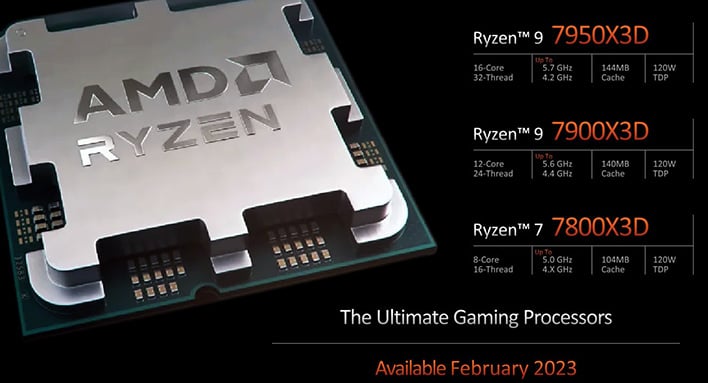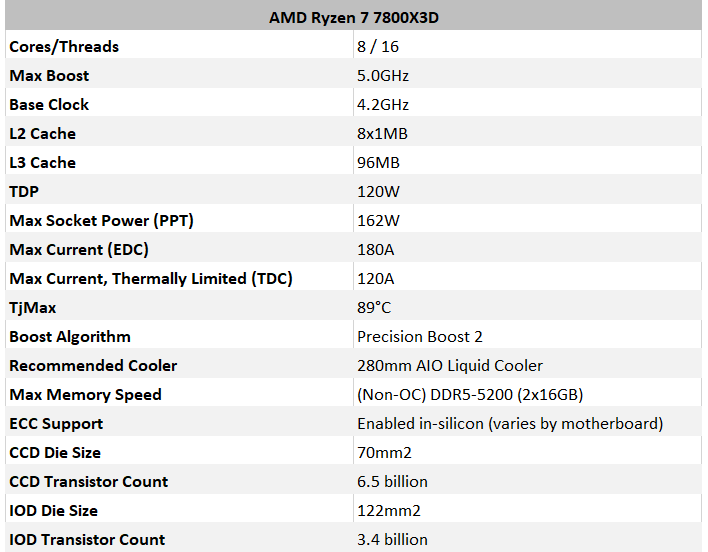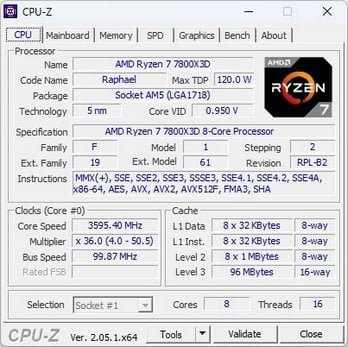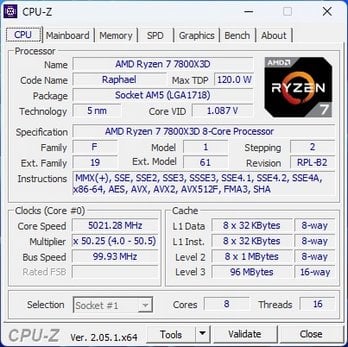AMD Ryzen 7 7800X3D Review: Return Of The PC Gaming King
AMD Ryzen 7 7800X3D: One Zen 4 CCD With 3D V-Cache Brings Monster Game Performance
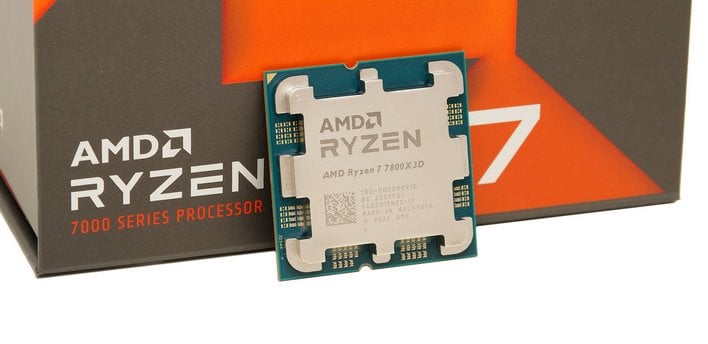
| AMD Ryzen 7 7800X3D - $449 MSRP The new Ryzen 7 7800X3D is an 8-core / 16-thread processor with 64MB of 3D V-Cache that offers class-leading PC gaming performance at much lower power than the competition.
|
|||

|

 |
||
Back in late February, we reviewed the AMD Ryzen 9 7950X3D, the company’s latest high-end processor for gamers and creators. As its name implies, the Ryzen 9 7950X3D is similar to the standard Ryzen 9 7950X in terms of its core counts and frequencies, but that "3D" bolted onto the end of its name means the chip is packing AMD’s 3D V-Cache technology that gives PC gaming a big performance boost. 3D V-Cache is essentially a healthy, 64MB serving of L3 cache, 3D stacked onto a Zen 4 die, to allow the processor to keep much more data close to the CPU cores, minimizing cache misses and calls out to system memory. The Ryzen 7 7800X3D, though fundamentally similar to the 7950X3D, has some key differences that make it particularly well-suited to gaming. Due to the fact that it has only one CCD (Core Chiplet Die), versus two in the Ryzen 9 7950X3D (and 7900X3D), there’s no asymmetry to contend with on the software level and overall latency is reduced, because there’s no inter-CCD communications necessary.
When AMD launched the previous-gen, single-CCD Ryzen 7 5800X3D, the company claimed the chip would be the PC gaming king. This time around, AMD is calling Ryzen 7 7800X3D “The Perfect Gaming Processor”. Well, nothing is ever perfect, but without spoiling things too much, we'd say AMD got pretty darn close. Take a look at the specs and other particulars, then we’ll get to some benchmarks and you’ll see what we mean...
The AMD Ryzen 7000X3D Processor Line-Up
Before you read any further, if you aren’t already intimately familiar with AMD’s Ryzen 7000X3D series, we have to point you to some previous coverage. Our review of the previous-gen Ryzen 7 5800X3D explains what 3D V-Cache is and how AMD implemented it in detail – that one definitely lays the foundation for what we’re going to show you here. Our review of the Ryzen 9 7950X3D details the changes with the current-gen AM5 line-up and how AMD’s chipset driver magic works.
And our special 2.5 Geeks Livestream with AMD's own David McAfee answers many questions about 3D V-Cache and is a really interesting watch. While you’re there, do us a solid and like and subscribe to our channel.
As most of you probably know, there are three processors in the Ryzen 7000X3D line-up, the Ryzen 7 7800X3D, the Ryzen 9 7900X3D, and the top-of-the-line Ryzen 9 7950X3D. Similar to the previous Ryzen 7 5800X3D, but unlike its higher-end brothers, the Ryzen 7 7800X3D features a single-CCD with 64MB 3D V-Cache attached, boosting it to a total of 96MB of L3 cache, or "104MB L2+L3" as AMD likes to label it.
Whereas the Ryzen 7 5800X3D took a 200MHz cut to its boost clock, due to the addition of 3D V-Cache, the Ryzen 7 7800X3D takes things even further and actually loses 400MHz of its max boost speed versus the standard Ryzen 7 7700X, which is its closest sibling in the standard Ryzen 7000 series line-up, despite the model numbering difference. Regardless, this chip still boosts to 5GHz, and its TDP also goes up this time, from 105W to 120W. In fact, all of the Ryzen 7000X3D processors have 120W TDPs.
In addition to the 7800X3D, AMD also offers the 12-core Ryzen 9 7900X3D (140MB L2+L3) and 16-core Ryzen 9 7950X3D (144MB L2+L3). Unlike the single CCD 7800X3D chip, the Ryzen 9 7950X3D retains its full 5.7 GHz boost clock versus the standard 7950X. However, that’s only because one of its CCDs is essentially left untouched -- only one of the processor’s 8-core CCDs gets the 3D V-Cache treatment. The CCD without 3D V-Cache operates like the standard 7950X, while the 3D V-Cache enabled CCD will have a more conservative voltage and frequency curve. The same is true of the Ryzen 9 7900X3D.
AMD Ryzen 7 7800X3D CPU-Z Details
As you’d expect, the Ryzen 7 7800X3D's actual processor package resembles every other socket AM5 chip. Save for the branding etched on top, the heat spreader and packaging remain unchanged from the other members of the Ryzen 7000 series. A quick glance at CPU-Z, however, will reveal the main differences...The screenshots above were captured with the AMD Ryzen 7 7800X3D at idle and under load. As you can see, there’s 104MB of L2 + L3 cache on board, and save for it frequencies, the remaining features of the chip look similar to a Ryzen 7 7700X. When idle, the core voltage drops way down and with single-threaded workloads, core clocks consistently hit the processor's rated 5GHz and stay pegged there. With multi-threaded workloads taxing every part of the chip, all-core frequencies typically hover in the 4.7 - 4.8GHz range with this CPU.
Let's kick off some benchmarks, next...

